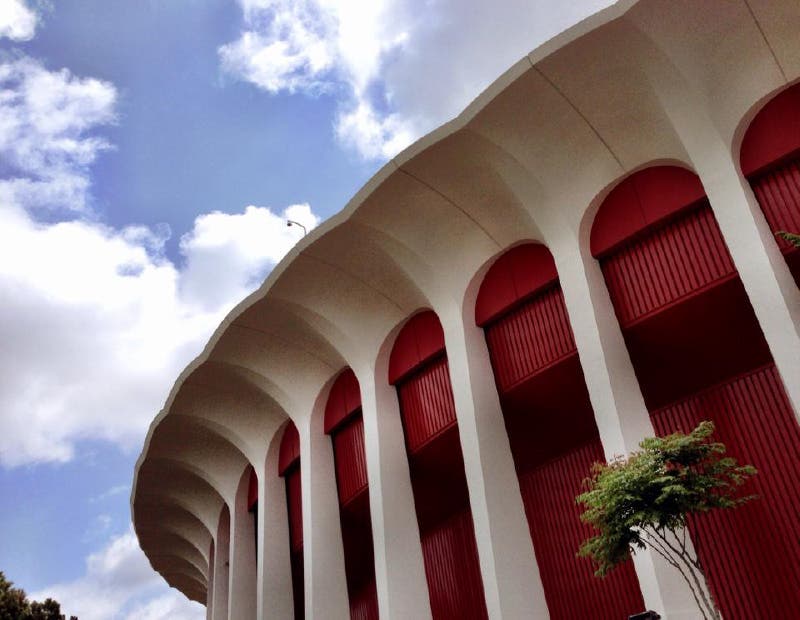
Peter Miller
What I Learned at the 2017 AIA Convention
For the second time in three years, the American Institute of Architects annual convention took place in a modern market. This is to say, AIA accredited, architectural tours of 18th and 19th century buildings were not available this year in Orlando Florida, except the Medieval castles at Disney World.
So, I’ve got modern on my mind, especially since the AIA Historic Resources Committee luncheon speaker gave an excellent presentation about Mid Century Modernism. Coincidentally, our magazines, OLD HOUSE JOURNAL and TRADITIONAL BUILDING each ran stories about modern houses and Mid- Mod non-residential buildings this month. Attention baby boomers! Some of the buildings you saw under construction, in your teens, are now, “historic.”
Our AIA HRC speaker, Christine M. French, Adjunct Professor, Historic Preservation Program, College of Design, Construction, Planning, University of Florida, reminded us that on the nearby Florida Southern College campus is the largest collection of Frank Lloyd Wright buildings anywhere in the country. The local architect who worked with Wright was Nils Schweizer. She informed us about Florida’s Mid-Century Modern architectural heritage, including works by Paul Rudolf (Sarasota); John Johansen (Orlando); Alfred Browning Parker (Miami); and Harry Merritt (Gainesville).
Citing her California roots and her enthusiasm for the modern buildings of her youth, Professor French showed us over 100 colorful slides of mid-century modern buildings all located in her adopted state of Florida. She has embarked on an ambitious project to document them, with the help of her students, in a project called, “Florida’s Mid-Century Modern Resources 1945-1975: Historic Context Statements & Identification of 50 Flagship Structures.”

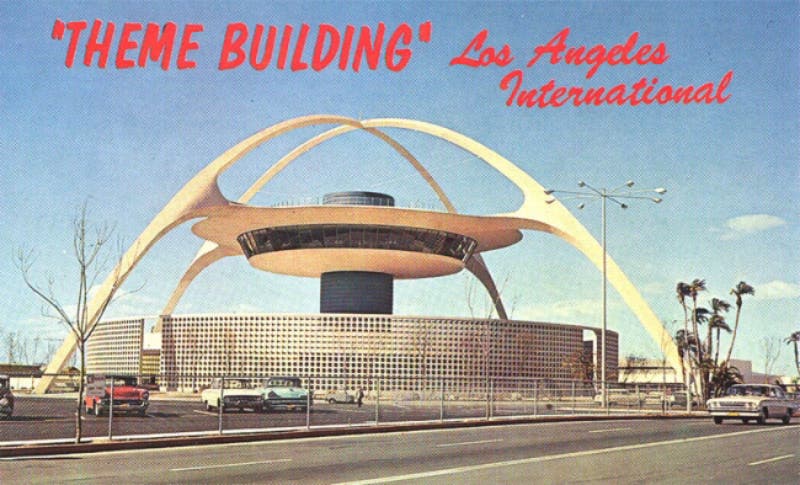
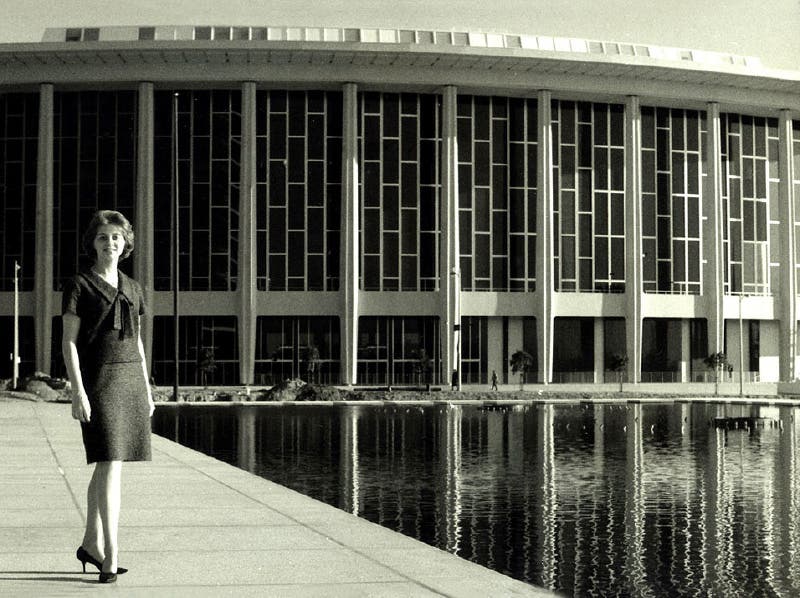
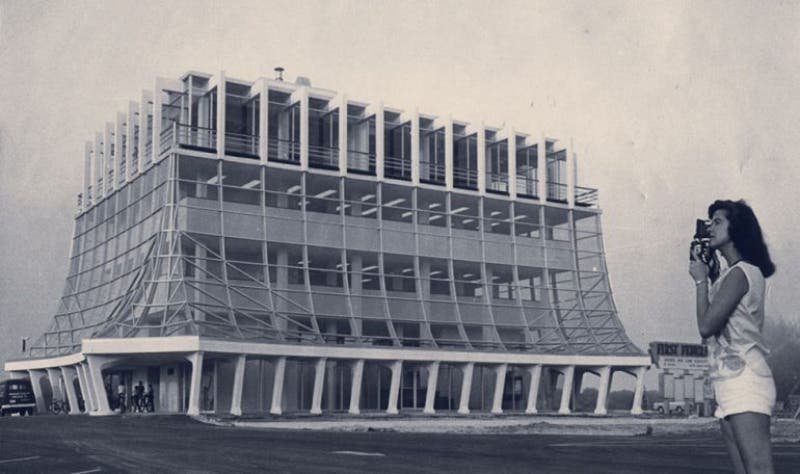
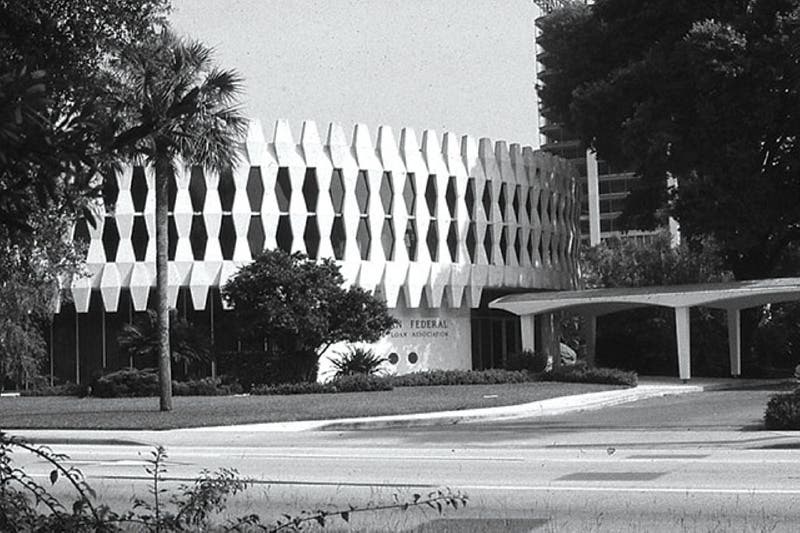
“A great number of historic sites remain unrecognized for their historic significance and contributions to Florida’s design history,” French explained. “Decades of changes to a structure, and regular use, can diminish or disguise the original design intent and obscure the character-defining features of a building. The research team is focused on identifying these ‘new’ historic resources.”
The project team will investigate by looking through the archived architectural collection at the University and through an analysis of period materials found in the monthly issues of FLORIDA ARCHITECT 1954-1975. They will discover the architects, materials and structures which were “heralded as groundbreaking at their inception/construction but might lack recognition today.” This is the research and data collections phase of the “”50 Flagship Resources” project.
Next comes the “Context Statement” phase which will detail larger movements throughout Florida, 1945-1975, examining the social and cultural impact on modern architecture. Buildings of all types will be considered, from churches to public housing. Professor French cited the desegregation of Florida’s public schools and its impact on design. “After desegregation, all the schools designed in Florida were modern,” French exclaimed.
Modernist Architects in Practice is a second part of the “Context” research phase and Architectural Trends, Forms, Materials and Expression are a third component of this survey. There was building material usage unique to Florida, such as “Ocala Block,” a concrete block invented for Frank Lloyd Wright’s buildings at Florida Southern College and used subsequently on houses around the state.
The final phase of “Florida’s Mid-Century Modern Resources 1945-1975: Historic Context Statements & Identification of 50 Flagship Structures” will be a road show to present the findings at several preservation conferences around the state which celebrate modern architecture. The criterion for choosing the “Flagship 50” will be to identify modern buildings, of all types, which are representative of “the overall design movement in the state of Florida.” The new use of modern materials; works by master architects and their impact on later works; and other icons which convey a design trend, including regional trends, will all be considered for the list of 50.
Sitting in the audience at the AIA Historic Resources Committee luncheon, listening to our speaker, I had my own epiphany: I like modern design but not necessarily modern materials. The Rice Krispies- concrete exteriors of so many Brutalist buildings isn’t pretty.
Modern materials were on display at the AIA Expo. Large window walls continue their trend, looking bigger and wider. I was entertained by the good folks at Pella who introduced new windows and features in their Architect Series. Better hardware, slimmer sight lines, putty glazing profiles, improved historic authenticity and an overall attention to window detail was their convincing demonstration to architects and the press.
I had a chat with Doug Bracken of Wiemann Metalcraft who has always specialized in complex traditional designs for ornamental metals, including bronze. Based on what he sees and hears, he is now promoting WMC’s modern design capabilities.
At least half of the AIA Continuing Education Credit education available were presentations by exhibitors on the expo floor. I saw one about traditional building: “Window Solutions for Historic Buildings.” There was a wide variety of others including, “Managing Moisture and Thermal Performance with Continuous Insulation,” and “Overcoming Structural Floor Squeaks in Wood Frame Construction.”
Architectural tours, too, were plentiful, including: “How Architects Help the Magic Kingdom to Remain the Most Magical Place on Earth” and over at Universal Studios: “The Wizarding World of Harry Potter Diagon Alley.”
Elsewhere around the annual AIA Convention there was a buzz about keynote speaker Michelle Obama. Our former First lady was giving her first public speech since leaving the While House in January. Her message: “Think about designing cities which are inclusive and accommodating, especially of the poor, who are often left behind.”
Obama helped the AIA remind us that we have an important role in making the world a better place.
Peter H. Miller, Hon. AIA, is the publisher and President of TRADITIONAL BUILDING, PERIOD HOMES and the Traditional Building Conference Series, and podcast host for Building Tradition, Active Interest Media's business to business media platform. AIM also publishes OLD HOUSE JOURNAL; NEW OLD HOUSE; FINE HOMEBUILDING; ARTS and CRAFTS HOMES; TIMBER HOME LIVING; ARTISAN HOMES; FINE GARDENING and HORTICULTURE. The Home Group integrated media portfolio serves over 50 million architects, builders, craftspeople, interior designers, building owners, homeowners and home buyers.
Pete lives in a classic Sears house, a Craftsman-style Four Square built in 1924, which he has lovingly restored over a period of 30 years. Resting on a bluff near the Potomac River in Washington, D.C., just four miles from the White House, Pete’s home is part of the Palisades neighborhood, which used to be a summer retreat for the District’s over-heated denizens.
Before joining Active Interest Media (AIM), Pete co-founded Restore Media in 2000 which was sold to AIM in 2012. Before this, Pete spent 17 years at trade publishing giant Hanley Wood, where he helped launch the Remodeling Show, the first trade conference and exhibition aimed at the business needs and interests of professional remodeling contractors. He was also publisher of Hanley Wood’s Remodeling, Custom Home, and Kitchen and Bath Showroom magazines and was the creator of Remodeling’s Big 50 Conference (now called the Leadership Conference).
Pete participates actively with the American Institute of Architects’ Historic Resources Committee and also serves as President of the Washington Mid Atlantic Chapter of the Institute of Classical Architecture & Art. He is a long-time member of the National Trust for Historic Preservation and an enthusiastic advocate for urbanism, the revitalization of historic neighborhoods and the benefits of sustainability, including the adaptive reuse of historic buildings.








